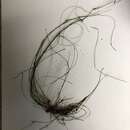en
names in breadcrumbs


Eleocharis vivipara is a species of flowering plant in the sedge family known by several common names, including umbrella hairgrass, sprouting spikerush, and viviparous spikerush. It is native to the southern United States from eastern Texas to eastern Virginia.[2] It takes the form of a clump of thin stems. A spike of flowers appears at the tip of the stem. The plant may also reproduce by growing a plantlet and runners.[3]
Eleocharis vivipara may grow in the water or on land. When it is aquatic it uses C3 carbon fixation pathways for photosynthesis. When it grows out of the water it switches to the C4 mechanism.
This species grows along the margins of water bodies, such as ponds, marshes, and ditches.
It can also be cultivated and used as an aquarium plant.[4]
Eleocharis vivipara is a species of flowering plant in the sedge family known by several common names, including umbrella hairgrass, sprouting spikerush, and viviparous spikerush. It is native to the southern United States from eastern Texas to eastern Virginia. It takes the form of a clump of thin stems. A spike of flowers appears at the tip of the stem. The plant may also reproduce by growing a plantlet and runners.
Eleocharis vivipara may grow in the water or on land. When it is aquatic it uses C3 carbon fixation pathways for photosynthesis. When it grows out of the water it switches to the C4 mechanism.
This species grows along the margins of water bodies, such as ponds, marshes, and ditches.
Ituluikka (Eleocharis vivipara) on luikkien sukuun kuuluva kasvilaji. Sitä kutsutaan myös nimellä tupsuneulaheinä[1], joka on hieman harhaanjohtava nimi, sillä laji ei kuulu heinäkasvien (Poaceae) heimoon, vaan sarakasvien (Cyperaceae) heimoon.
Ituluikan varret ovat poikkileikkaukseltaan leveän soikeita ja ituluikka muistuttaa ulkonäöltään paljolti muita luikkia. Ituluikan voi sekoittaa muun muassa Eleocharis microcarpa, Eleocharis brittonii tai Eleocharis baldwinii -lajeihin. Ituluikka muodostaa usein tiheitä kasvustoja lähestulkoon pelkästään kasvullisesti.[2] Ituluikka voi kasvupaikastaan riippuen yhteyttää joko C3- tai C4-metabolian kautta.
Ituluikka kasvaa erilaisilla kosteilla, hiekka- tai turvepohjaisilla paikoilla, kuten järvien rannoilla, ojissa, kosteikoilla sekä marskimailla. Ituluikkaa tavataan luontaisena Yhdysvaltojen eteläosissa, kuten Floridassa, Virginiassa ja Texasissa[3]. Suomessa ituluikkaa ei tavata luonnonvaraisena.
Ituluikkaa käytetään akvaariokasvina ja siitä on myynnissä eri lajikkeita tähän tarkoitukseen.
Ituluikka (Eleocharis vivipara) on luikkien sukuun kuuluva kasvilaji. Sitä kutsutaan myös nimellä tupsuneulaheinä, joka on hieman harhaanjohtava nimi, sillä laji ei kuulu heinäkasvien (Poaceae) heimoon, vaan sarakasvien (Cyperaceae) heimoon.
Ituluikan varret ovat poikkileikkaukseltaan leveän soikeita ja ituluikka muistuttaa ulkonäöltään paljolti muita luikkia. Ituluikan voi sekoittaa muun muassa Eleocharis microcarpa, Eleocharis brittonii tai Eleocharis baldwinii -lajeihin. Ituluikka muodostaa usein tiheitä kasvustoja lähestulkoon pelkästään kasvullisesti. Ituluikka voi kasvupaikastaan riippuen yhteyttää joko C3- tai C4-metabolian kautta.
Ituluikka kasvaa erilaisilla kosteilla, hiekka- tai turvepohjaisilla paikoilla, kuten järvien rannoilla, ojissa, kosteikoilla sekä marskimailla. Ituluikkaa tavataan luontaisena Yhdysvaltojen eteläosissa, kuten Floridassa, Virginiassa ja Texasissa. Suomessa ituluikkaa ei tavata luonnonvaraisena.
Ituluikkaa käytetään akvaariokasvina ja siitä on myynnissä eri lajikkeita tähän tarkoitukseen.
Eleocharis vivipara là loài thực vật có hoa trong họ Cói. Loài này được Link mô tả khoa học đầu tiên năm 1827.[2]
Eleocharis vivipara là loài thực vật có hoa trong họ Cói. Loài này được Link mô tả khoa học đầu tiên năm 1827.